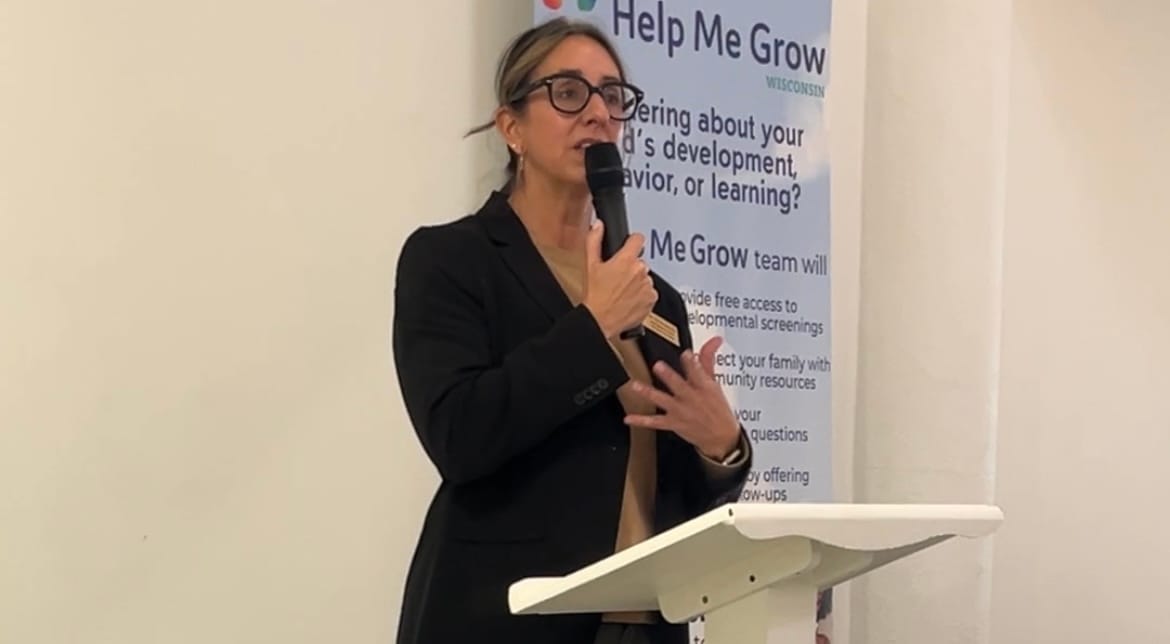Roundtable seeks long-term solutions to childcare crisis
The conversation touched on the issues underpinning the crisis: low wages for overworked teachers; low teacher retention; high costs for families (sending two children to childcare for a full year runs nearly $30,000); low industry margins; and long waiting lists and unfilled slots.
Last July, for the first time in state history, the state of Wisconsin offered funds to support its childcare industry. All told, the biennial budget ponied up $360 million for an industry that all agree is not only critical to families and businesses but is woefully underfunded. Of that $360 million, all but $66 million of it was carryover from Covid-era ARPA money, President Biden’s American Rescue Plan that was enacted to help states and municipalities through the economic crunch of the pandemic.
But while some in the childcare industry were just happy with the lifeline that state allocation provided, almost everyone recognized it for the temporary fix it was, or as one legislator called it at the time, “a bandaid when we need a tourniquet.”
For one thing the ARPA money is not renewable and when it’s gone, it’s gone for good. And that $66 million in actual state money for the Get Kids Ready Initiative that is designed to prepare four-year-olds for kindergarten and beyond came with policy prescriptions that most in the childcare industry are opposed to. Those include an increase in teacher-to-child ratios from one-to-four to one-to-seven and the lowering of the qualifying age for childcare center teachers from 18 to 16.
Rep. Lee Snodgrass (D-Appleton) kicks off the childcare roundtable on Nov. 3 at the old Trout Museum in Appleton
Seeking long-term solutions
To wrangle with the decisions and roadblocks the state still faces and to discuss potential solutions, State Representatives Lee Snodgrass (D-Appleton) and Alex Joers (D-Waunakee) along with State Senator Kristin Dassler-Alfheim (D-Appleton) held a roundtable with a collection of area stakeholders on Nov. 3 at the old Trout Museum (soon to be the site of First Five Fox Valley). Those stakeholders included childcare center owners themselves, early childhood development leaders and two state administrators at the heart of childcare policy: Department of Children and Families Secretary Jeff Pertl and DCF’s Division of Early Care and Education Administrator Priya Bhatia.
The conversation touched on the issues underpinning the crisis: low wages for overworked teachers; low teacher retention; high costs for families (sending two children to childcare for a full year runs nearly $30,000); low industry margins; and long waiting lists and unfilled slots.
“I had a student last year who came on part-time during the summer and her co-workers were telling her about the amazing T.E.A.C.H scholarship program (for people going into early childhood education) and she was, like, oh my gosh, this is too good to be true,” said Nicole Desten of Bridges Early Childhood Enrichment Center. “Only to find out what her wages were going to be for the rest of her life. After a year, she made the decision to change her major because she needs a sustainable, livable wage. And that's just not possible (in the childcare industry currently).”
Destin said she lost someone who had been with her for 18 years to Head Start, which offered her five dollars more per hour plus state benefits.
“We know it's a very stressful profession, that burnout is high,” Desten added. “But you know, if you had adequate money, I could keep those people working for me, and I could do my job. But I cannot pay them enough and I cannot give them what they deserve.”
It is almost always women who bear the burden of the crisis, either as workers in the industry or in having to make the decision to surrender a career when childcare is unavailable or unaffordable.
Julie Keller, the executive director of the Women’s Fund, said women are punished in ways that affect them long-term, especially when it comes to earning power in their prime years.
“What are we saying when we say a woman should just stay home?” she asked. “We're jeopardizing her financial stability throughout her entire life because she can't go to work and because they can't afford childcare. What are the long term ramifications with that? And women are the primary workers in these child care centers, and they're making minimal wages.”
Middle class squeeze
Tiffany Simon and Virginia Maus of Dale decided to go into the business themselves when they found out the only childcare center in the area would close in a year. Simon had three children and a fourth on the way.
“I was going to have to leave the workforce,” she said. “It was just gonna be too expensive having a fourth child. I have a doctorate degree so an educated person was not going to be making this money, to be growing my career.”
Virginia Maus of Joyful Beginnings in Dale
They opened Joyful Beginnings in rural Outagamie County three years ago, immediately grasped the economic realities of making it work and raised tuition $100 per child per week. While it put a strain on their families, it was a necessary adjustment to stay open.
“We asked every one of our parents what they would do if we closed today and 75 percent of them said that one of the parents would have to leave the workforce,” Maus said.
Julie Stoffel of Cradle to Crayons Learning Center in Kimberly brought sobering numbers to the roundtable on Monday. In Outagamie County, she pointed out, almost 900 of 5,400 needed childcare slots are unfilled due to teacher shortages. It would require, she said, more than 107 more teachers to fill those empty slots.
“We have a serious issue,” she said. “We are serving largely middle class families that are vulnerable, and moms are leaving the workforce. We used to be a state with one of the highest female participation rates in the workforce and now we’re one of the lowest.”
Rep. Snodgrass referred to the “missing middle,” those who make too much money to qualify for assistance but not enough to be able to afford the approximately $15,000 per year for full time childcare.
Pertl noted that 40% of a typical Wisconsin family’s income goes to housing and an additional 30% goes for childcare. With two kids in childcare that number doubles and, suddenly, that entire paycheck is gone.
“I also buy food for my kids,” he said. “I pay for my phone and my heat, internet gas, my car, college loans and all the things. If you add that stuff up, it's like 185% of the median household income is what you need just to do the basics. That’s a very real thing people are living.”
Among the solutions proposed was something that has been tried – with some success – in states such as Vermont and Connecticut: business support for the industry. Businesses, after all, are impacted when needed employees are unable to work when the cost of childcare makes it economically nonviable. In Connecticut, for instance, a .44 percent payroll tax has helped undergird the state’s childcare.
“I think one of the things that we need is to begin to look at the system of child care as funded not only from parents or through various county programs and state programs but also how to engage the business community into investing in the child care centers where it's productive for their own employees,” said Liz Filter, the CEO of VARC, Inc., a non-profit that works with people with needs as well as children and youth. “It builds better retention, can be a strong recruitment tool and can be used, as it was in our case, to invest in the wages of the childcare center employees, to include full time benefits and higher rates of pay without passing along the full scope of that expense to parents directly.”
Two bills introduced last year in the state legislature provide tax credits to businesses willing to participate in such support.
‘We all rise’
“We are trying to find ways we can entice those businesses to look beyond their own building and really not be afraid to help the entire (Fox) Valley,” Sen. Dassler-Alfheim said. “If our business community is given the incentive on a legislative basis, they can look beyond their own walls because if the Fox Valley child care industry rises, we all rise with it and so do our businesses.”
Taylor Vande Vyer of Wisconsin Early Childhood Association and a mother of two children in childcare wondered why the state or federal government couldn’t help subsidize her employer’s dependent day care FLEX plan which maxes out at $7,500 a year, or about a fourth of her annual cost.
“I would love the idea of the state fund, or even pressing the federal more, but probably more on the state level,” Vande Vyer said. “Like, what can we do to close that gap even further? I like the idea of a sliding scale with employers.”
While Dassler-Alfheim said she understands that businesses can’t be the only solution to the crisis, they ought to recognize how integral childcare is to their bottom line.
“The saddest thing I heard was during National Day Without Childcare (a day of action to call attention to the crisis) a CEO asking (the owner of the childcare center they used), ‘You guys aren’t going to shut down, are you?’” Dassler-Alfheim said. “And I thought, really? You're going to put that on your child care agency, not to make a statement of how valuable they are? And I think that is so impactful, because if all of the child care agencies shut down, where would we be economically?”
Not everyone agreed that looking to business is the answer, either because small businesses would be hurt or because, philosophically, this is a societal issue that society should be willing to address. Oliver Zornow of the Building for Kids argued that we don’t go to businesses to help fund new highway construction, though he said he understands how business benefits from such investment.
“We subsidize almost everything except for (childcare),” he said. “And the way we do this is needs-tested and yet no one's checking if the people who are driving on that extra lane on (Interstate) 41 can afford to pay more or less, and so I don't understand why this is different.”
Nancy Jones of First Five Fox Valley echoed Zornow’s sentiment, wondering about the impact on small businesses and worrying about an overreliance on business to fund what she, like Zornow, sees as a public obligation.
“I'm more in the mindset that childcare is a public good,” she said. “If you provide incentives for large businesses you put small businesses at a disadvantage in terms of attracting employees.”
Impact of larger class ratios
As for the new child-to-teacher ratios, Secretary Pertl of the Department of Children and Families, says they seem to be holding up okay, though most are going to one-to-five as opposed to one-to-seven, which he thinks creates too much demand on already overburdened staff and would make retention an even larger problem. One way Maus and Simon of Joyful Beginnings are dealing with the retention issue is by offering discounted childcare to their own employees. But they admit it isn’t easy, costing them $75,000 last year.
Priya Bhatia, Administrator for the Department of Children and Families Division of Early Care and Education, discusses the new classroom ratios.
Stoffel of Cradle to Crayons, said the higher ratios bring higher insurance into the picture and that’s an expense that childcare centers, operating often on margins as low as one percent, cannot absorb.
“It is very hard to stay insured, not to mention our rates are increasing at astronomical amounts,” she said. “So just know that when we talk about ratios and things like that, it can greatly impact that, and if we don't have insurance, we are not operating. It’s something we are really grappling with and there are only a couple of insurance companies in the state that will cover us right now.”
The conversation is headed in the right direction
Pertl, the Wisconsin DCF Secretary, said he sees the answer somewhere in the middle and that flexibility may be the key. We must be aware of the impact on businesses of shifting the burden too dramatically in that direction, he argued.
“I don’t want to make (the solution) too business-reliant because maybe that would be an optimistic vision for how business would step up and really make this thing work,” Pertle said. “But I think it's part of a solution that is primarily driven by state policies (supporting) providers that's going to carry most of the weight. And then you're layering in that business support, that flex savings piece that is like the icing on the cake, but I don't really think it's the cake.”
Ultimately, he said he is optimistic about how the ongoing discussions of the childcare crisis and the fact that it is a generational and not partisan issue are gradually putting everyone on the same page, at least in recognition that it is, in fact, a crisis.
Secretary of the Department of Children and Families Jeff Pertl closes the childcare roundtable on a positive note.
“There's lots of different ways for us to build a robust system,” he said. “How do we help young families thrive? Food bills are expensive. Paying for food is helpful. And no one can afford to go to the grocery store right now. So those are real things, and I do believe, despite all the craziness of the world, that we are in the midst of a transformation about how people are approaching childcare. We see states doing bigger, bolder things.
“I do believe in the next two to six years, we're going to make some big changes and start to see it within the decade play out across all the states.”
Rep. Snodgrass concluded the roundtable by echoing Secretary Pertl’s optimism.
“I always remind people that you may not feel like you have power, but, as (Rep. Joers) pointed out, think about where this conversation was even just a few years ago,” she said. “Policy does not change until public opinion changes. Public opinion drives policy, which is why we have conversations like this, which is why we invite media, which is why we amplify this on our pages. That is the power that we have when we don't have the power that we want.”
Roundtable seeks long-term solutions to childcare crisis © 2025 by Kelly Fenton is licensed under CC BY-NC-ND 4.0







